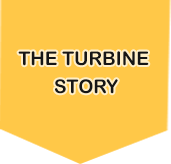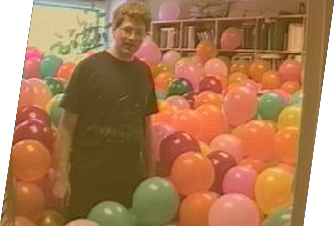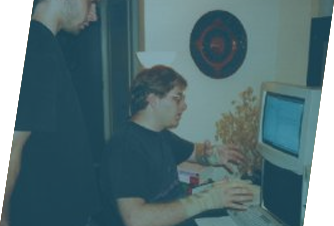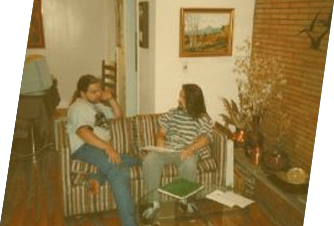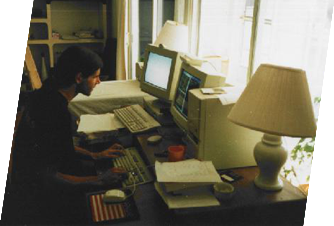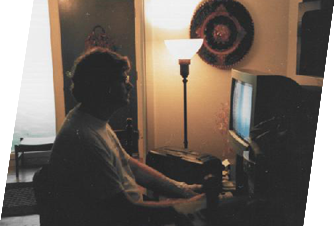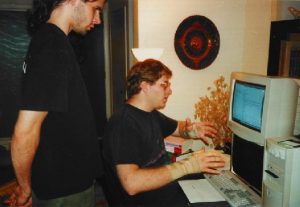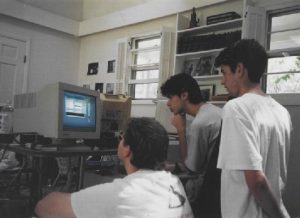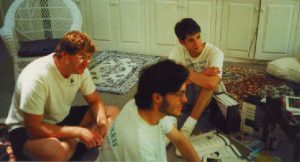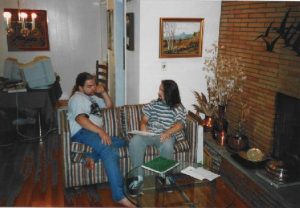


What I was doing instead of preparing, the day before my Master's presentation.Eventually, I realized my heart was really not in academia, as I describe in detail (including two crazy but nice pranks), in my forthcoming book Soulburners. Meanwhile, I was getting more and more excited about a new project, an idea that gripped and wouldn't let go. I've always been a big projects person. At MIT we'd call that the "work hard, play hard" attitude. I would get hooked on some undertaking, and just go go go. Like most entrepreneurs, I was long on enthusiasm and short on experience. I read in The Economist magazine that the Internet was the next big thing, and that was certainly my own experience. In the computer science department I was the "Internet guy" because I'd taken the time to play with the plonky and terrible tools that were available at the time. In February 1994 I gave a department lecture with an overview of all the tools like Gopher, a kind of text-only browser, and Netscape, the first real browser. [post_title] => Too good an idea to let go [post_excerpt] => [post_status] => publish [comment_status] => open [ping_status] => open [post_password] => [post_name] => a-good-idea [to_ping] => [pinged] => [post_modified] => 2017-05-24 20:15:30 [post_modified_gmt] => 2017-05-24 23:15:30 [post_content_filtered] => [post_parent] => 0 [guid] => https://johnny-monsarrat.com/?p=868 [menu_order] => 0 [post_type] => post [post_mime_type] => [comment_count] => 0 [filter] => raw ) [1] => WP_Post Object ( [ID] => 678 [post_author] => 4 [post_date] => 2017-04-24 18:03:17 [post_date_gmt] => 2017-04-24 21:03:17 [post_content] => Of course the idea involved computer games. Every programmer I knew wanted to want to write a computer game. So it's was going to be a game... on the Internet. Right! It had to use the most cutting edge technology. If it weren't a challenge, it wouldn't be fun. At MIT, I had done a lot of live roleplaying. This is basically improvisational theater: Dungeons & Dragons, live and on stage. I was one of the actors and playwrights. It was a lot like what I thought online gaming should be: live roleplaying on the Internet. I'd almost started a company to do live roleplaying in the real world back in 1991. Imagine thousands of people in some kind of huge graphical chat, playing wizards and fighters and magicians. They call this a Multi-User Dungeon (MUD), but it would be more than a MUD. It would be a huge party. It would be the biggest, longest roleplaying game ever. I knew a lot about roleplaying, but always been too busy for MUDs. However, the Artificial Intelligence Lab at Brown was a hackers' paradise, and a bunch of us tossed around names for a company, eventually choosing "Cyberspace", a word from science fiction. This would turn out to be a terrible name. I didn't have a garage, so we set up shop in my studio apartment. Talk about "living at work"! I only had one laptop computer, and could barely afford one desktop computer for UI development. Tim Miller, one of the computer graphics experts at Brown, gave me a stack of research papers and lots of advice, and I started writing the 3D graphics software. Then a bunch of friends and I set up in my mother's house. First we camped out in her living room. Then we spread to her family room. Then we took over the basement, and she moved out! She went to live with her boyfriend for the summer. We took over every room in the house except the garage! [row] [column md="6"] [/column] [column md="6"] [/column] [/row] [post_title] => Everything but the garage [post_excerpt] => [post_status] => publish [comment_status] => closed [ping_status] => closed [post_password] => [post_name] => four-guys-and-a-garage [to_ping] => [pinged] => [post_modified] => 2017-06-03 14:53:37 [post_modified_gmt] => 2017-06-03 17:53:37 [post_content_filtered] => [post_parent] => 0 [guid] => https://johnny-monsarrat.com/?page_id=678 [menu_order] => 1 [post_type] => post [post_mime_type] => [comment_count] => 0 [filter] => raw ) [2] => WP_Post Object ( [ID] => 684 [post_author] => 4 [post_date] => 2017-04-24 18:05:08 [post_date_gmt] => 2017-04-24 21:05:08 [post_content] => September 1994 was almost the end of Johnny Monsarrat. I was walking in Providence, and suddenly an accident forced a car up onto the sidewalk. Bam! I went flying. Fortunately I survived, and thanks to the personal injury system I got $30,000. It wasn't much, but it let me afford to become Turbine's first full-time employee in January 1995. None of us had any experience in business, but I'd done lots of leadership at school and thought I could hack it. So I read some books, spoke with businesspeople, and tried to figure it out. In early 1995, the startup center at Brown University gave us a lot of advice on starting a company and helped me to compile our first business plan. The leader of the department also wanted to invest, and it was weird to be taking business advice from a guy who was "on the other side of the table" negotiating an investment, so we ended up turning down the extra money. We gave presentations to businesspeople and they asked us a lot of tough questions. At first I had practically none of the answers. However, by keeping an open mind and learning from my mistakes, things slowly came together. The team and I went to Papa Gino's, a pizzeria, for their all-you-can-eat lunch, and I noticed that the drinks were included. Why weren't they making extra money by charging for the drinks? Suddenly I had an epiphany. I had always enjoyed solving puzzles, which to me had always led me towards a career in technology. But businesspeople solve puzzles too -- puzzles like how to make money from an all-you-can-eat lunch and puzzles of interacting with people. This was something I could tackle. [row] [column md="6"] [/column] [column md="6"] [/column] [/row] [post_title] => An unusual way to raise money [post_excerpt] => [post_status] => publish [comment_status] => closed [ping_status] => closed [post_password] => [post_name] => an-unusual-fundraiser [to_ping] => [pinged] => [post_modified] => 2017-05-24 20:51:43 [post_modified_gmt] => 2017-05-24 23:51:43 [post_content_filtered] => [post_parent] => 0 [guid] => https://johnny-monsarrat.com/?page_id=684 [menu_order] => 2 [post_type] => post [post_mime_type] => [comment_count] => 0 [filter] => raw ) [3] => WP_Post Object ( [ID] => 687 [post_author] => 4 [post_date] => 2017-04-24 18:06:07 [post_date_gmt] => 2017-04-24 21:06:07 [post_content] => But we were too dreamy-eyed to care. Meanwhile, we began the game design. A great looking game that's no fun is a failure. I had a live roleplaying angle on everything, shedding some light on workable game balance and plot mechanics. We wanted to fix some of the game design problems in MUDs. For example, experienced older players would get bored because they had seen everything in the fantasy word, and to kill time, they would kill new players. This wasn't fun for the older players and of course it was terrible for the new ones! So for our game, I added a concept where a new player could "pledge allegiance" to a more experienced player. The old player would get an automatic percentage of the new player's earnings (the loot and game scores that come with a videogame). This would create an incentive for older players to support, not attack, the newbies. Also, it gave the newbies someone to help them learn the game. As our first full-time employee, I was able to write a computer graphics engine. This engine got us some attention and combined with our business plan gave the company enough stability to merit some investment. Having turned down investment from "angels", we instead got funding by begging our friends and family. We also hired talented visionaries who believed in the company, and accepted lower salaries plus a ton of stock. This made our investment money last longer. It also meant that our company was truly employee-owned. [gallery size="medium" link="file" ids="895,896,898,899,897"] [post_title] => Rehoboth Office [post_excerpt] => [post_status] => publish [comment_status] => closed [ping_status] => closed [post_password] => [post_name] => rehoboth [to_ping] => [pinged] => [post_modified] => 2017-06-04 12:49:05 [post_modified_gmt] => 2017-06-04 15:49:05 [post_content_filtered] => [post_parent] => 0 [guid] => https://johnny-monsarrat.com/?page_id=687 [menu_order] => 3 [post_type] => post [post_mime_type] => [comment_count] => 0 [filter] => raw ) [4] => WP_Post Object ( [ID] => 889 [post_author] => 4 [post_date] => 2017-05-24 20:56:22 [post_date_gmt] => 2017-05-24 23:56:22 [post_content] => At last we built enough of a product to be able to give real demos. And our business plan and business savvy kept improving. By this time we had the game roughly planned out. We had hired a game designer, Toby Ragaini, who built the backstory for the game. I had architected, at the highest level, the modules for the large software engine that supports the game. Plus several of the modules had been mapped out in detail. My own projects were designing and writing a graphics engine, a toolkit for our artists to use the system, and the "physics system" that allowed objects to collide with one another and interact in our 3D virtual world. Ironically, although I'd left academia, doing this design took quite a bit of academic research. I loved it. The team spent hours and hours in design meetings and poring over research papers. But I became too busy for programming, instead focusing entirely on business. Other programmers took my modules and they went through many improvements and revisions before our first game shipped. Getting any product mass produced, advertised, and distributed around the country was too expensive for any new startup. Large companies, the publishers, specialized in finding talent and bringing that talent to the world. We needed a business to get our product to market. We were the developers hoping to get spotted by talent scouts at publishing companies. The entire summer's work went towards this goal. [post_title] => Demos, Demos, and More Demos [post_excerpt] => [post_status] => publish [comment_status] => open [ping_status] => open [post_password] => [post_name] => demos [to_ping] => [pinged] => [post_modified] => 2017-05-27 15:48:20 [post_modified_gmt] => 2017-05-27 18:48:20 [post_content_filtered] => [post_parent] => 0 [guid] => https://johnny-monsarrat.com/?p=889 [menu_order] => 4 [post_type] => post [post_mime_type] => [comment_count] => 0 [filter] => raw ) [5] => WP_Post Object ( [ID] => 903 [post_author] => 4 [post_date] => 2017-05-24 21:58:20 [post_date_gmt] => 2017-05-25 00:58:20 [post_content] => Finally, our business advisors thought we were ready to show our stuff to the outside world. For this grand opening, I took a trip to the "Online Game Developers Conference" in September 1995, run by a major market research company. With nothing but a one-page screen snapshot and our company story, I met and mingled with lots of companies in the online world. Until then, it was only an informed guess that we had a hot company with a solid vision. But we started to get feedback from people in the industry. At the conference, Turbine did better than we had hoped. Large companies like America Online and Compuserve were approachable. People loved the concept. I met many people from game companies that didn't seem to have the same vision and technology. We were ready to begin a serious search for a publisher. Would anyone want to bring our game to market? How else could we get onto the shelves of all the stores that sold software? [gallery size="medium" ids="908,907,906,905,910,909"] [post_title] => Mom's House [post_excerpt] => [post_status] => publish [comment_status] => open [ping_status] => open [post_password] => [post_name] => moms-house [to_ping] => [pinged] => [post_modified] => 2017-06-04 12:14:30 [post_modified_gmt] => 2017-06-04 15:14:30 [post_content_filtered] => [post_parent] => 0 [guid] => https://johnny-monsarrat.com/?p=903 [menu_order] => 5 [post_type] => post [post_mime_type] => [comment_count] => 0 [filter] => raw ) [6] => WP_Post Object ( [ID] => 604 [post_author] => 4 [post_date] => 2017-04-18 11:47:24 [post_date_gmt] => 2017-04-18 11:47:24 [post_content] =>
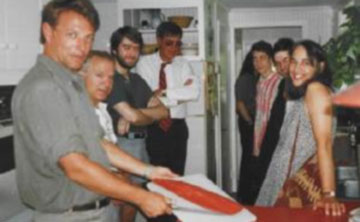
We learned a lot about running a business through preparing for these demos. Here we get salmon as a reward.
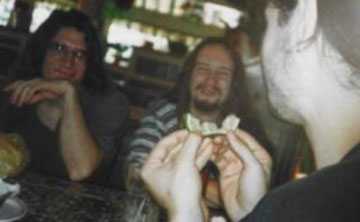
We stuck to a "no demo code" rule, meaning that we would never write throw-away software just for a demo.
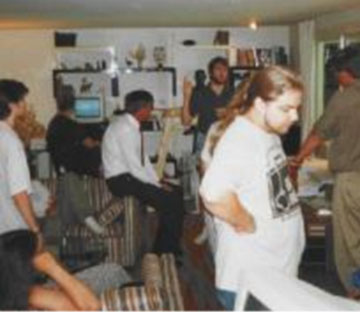
Tim describes one of the technologies that gives our company an edge over the competition.
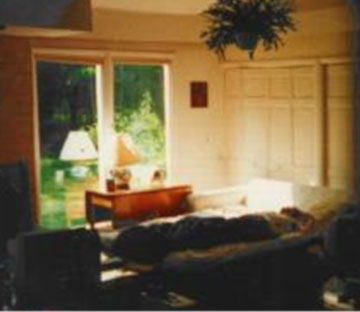
We're working so hard, people start sleeping here.
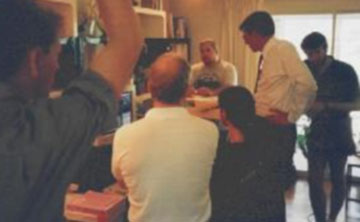
The demo of a man walking through a simple house, with the user interface laid out.
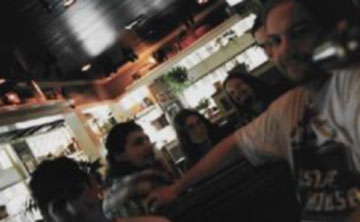
Celebrating after the demo. Zach, Larry, Scott, Toby, Chris, Jeremy.
What I was doing instead of preparing, the day before my Master's presentation.Eventually, I realized my heart was really not in academia, as I describe in detail (including two crazy but nice pranks), in my forthcoming book Soulburners. Meanwhile, I was getting more and more excited about a new project, an idea that gripped and wouldn't let go. I've always been a big projects person. At MIT we'd call that the "work hard, play hard" attitude. I would get hooked on some undertaking, and just go go go. Like most entrepreneurs, I was long on enthusiasm and short on experience. I read in The Economist magazine that the Internet was the next big thing, and that was certainly my own experience. In the computer science department I was the "Internet guy" because I'd taken the time to play with the plonky and terrible tools that were available at the time. In February 1994 I gave a department lecture with an overview of all the tools like Gopher, a kind of text-only browser, and Netscape, the first real browser. [post_title] => Too good an idea to let go [post_excerpt] => [post_status] => publish [comment_status] => open [ping_status] => open [post_password] => [post_name] => a-good-idea [to_ping] => [pinged] => [post_modified] => 2017-05-24 20:15:30 [post_modified_gmt] => 2017-05-24 23:15:30 [post_content_filtered] => [post_parent] => 0 [guid] => https://johnny-monsarrat.com/?p=868 [menu_order] => 0 [post_type] => post [post_mime_type] => [comment_count] => 0 [filter] => raw ) [comment_count] => 0 [current_comment] => -1 [found_posts] => 20 [max_num_pages] => 2 [max_num_comment_pages] => 0 [is_single] => [is_preview] => [is_page] => [is_archive] => [is_date] => [is_year] => [is_month] => [is_day] => [is_time] => [is_author] => [is_category] => [is_tag] => [is_tax] => [is_search] => [is_feed] => [is_comment_feed] => [is_trackback] => [is_home] => 1 [is_privacy_policy] => [is_404] => [is_embed] => [is_paged] => [is_admin] => [is_attachment] => [is_singular] => [is_robots] => [is_favicon] => [is_posts_page] => [is_post_type_archive] => [query_vars_hash:WP_Query:private] => 0c0413567215d9e4ae301d29dfc0efb2 [query_vars_changed:WP_Query:private] => [thumbnails_cached] => [allow_query_attachment_by_filename:protected] => [stopwords:WP_Query:private] => [compat_fields:WP_Query:private] => Array ( [0] => query_vars_hash [1] => query_vars_changed ) [compat_methods:WP_Query:private] => Array ( [0] => init_query_flags [1] => parse_tax_query ) [query_cache_key:WP_Query:private] => wp_query:a81ad7a4d3c6a7279e25011717b4c802:0.72222900 1765724885 )
News from Johnny Monsarrat
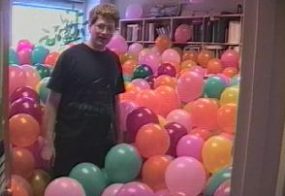
Too good an idea to let go
April 1994. I was a PhD student at Brown University in computer science, building mobile robots and programming them to roll around. It was great fun to stay up all night hacking away at the code. Managing projects and going to robot contests was to me more fun than the mathematically-oriented artificial intelligence research I […]
READ MORE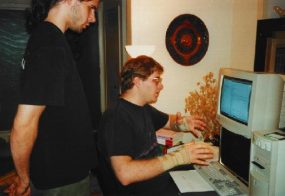
Everything but the garage
Of course the idea involved computer games. Every programmer I knew wanted to want to write a computer game. So it’s was going to be a game… on the Internet. Right! It had to use the most cutting edge technology. If it weren’t a challenge, it wouldn’t be fun. At MIT, I had done a […]
READ MORE
An unusual way to raise money
September 1994 was almost the end of Johnny Monsarrat. I was walking in Providence, and suddenly an accident forced a car up onto the sidewalk. Bam! I went flying. Fortunately I survived, and thanks to the personal injury system I got $30,000. It wasn’t much, but it let me afford to become Turbine’s first full-time […]
READ MORE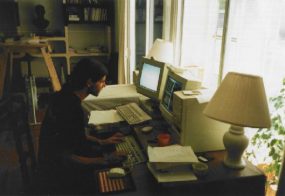
Rehoboth Office
As I mentioned, Turbine's first real office was in my Mom's house in Rehoboth, Massachusetts. The summer of 1995 was a hot one and we had no air conditioning.
READ MORE
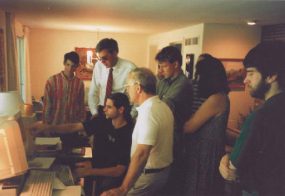
Demos, Demos, and More Demos
At last we built enough of a product to be able to give real demos. And our business plan and business savvy kept improving. By this time we had the game roughly planned out. We had hired a game designer, Toby Ragaini, who built the backstory for the game. I had architected, at the highest […]
READ MORE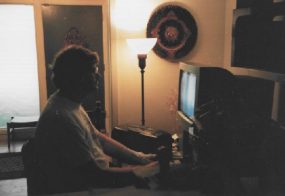
Mom’s House
Meanwhile we kept expanding. The living room was turned into a communal work area.
READ MORE
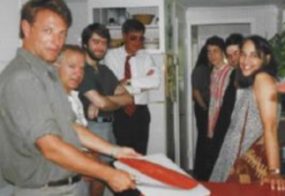
Demo
Before we spoke with any publishers, we gave "internal" demos to businesspeople friendly to the company. This is a fun story that I also include as a chapter in my forthcoming book, Soulburners. Johnny Monsarrat, Jeremy Gaffney, Tim Miller, and Toby Ragaini are featured.
READ MORE
Expansion at Rehoboth
Camp Turbine at the Johnny Monsarrat household. As I mentioned earlier, we started expanding until about 10 people worked in Mom's house in Rehoboth, most of them parking in the driveway and basically living there. Me, well, of course I lived there to begin with. We worked very hard. Imagine 12 geeky guys staying up until 4am and reviving around noon. Rehoboth was a tiny town with only 10,000 people and tons of forest, a bit of Iowa plunked into Massachusetts. What a strange place to start a company in!
READ MORE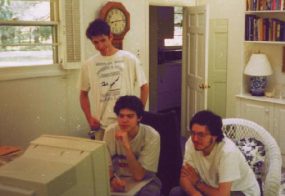
More Expansion at Rehoboth
Here are some shots of the chaos that the artists' room became. This was also the room we used for "stalling" a demo that we were still working on when guests arrived!
READ MORE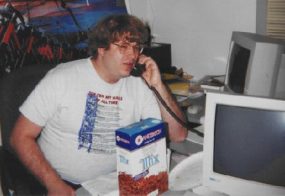
Providence
In late 1995 we moved into a new office in Providence, Rhode Island. As well as our working space improving, we had gained some investment and some organizational efficiency. We grew to 15 employees here. I also grew in the tummy area. That's proof that starting a company creates stress!
READ MORETurbine, Inc.
In 1994, Johnny Monsarrat founded Turbine, which created MMO Gamming, now a $20B market.
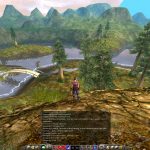
Monsarrat, Inc.
In 2016, Johnny and many former Turbine staff created Monsarrat, Inc., inventors of Big Movement Gaming.

Turbine, Inc.
In 1994, Johnny Monsarrat founded Turbine, which created MMO Gamming, now a $20B market.

Monsarrat, Inc.
In 2016, Johnny and many former Turbine staff created Monsarrat, Inc., inventors of Big Movement Gaming.




